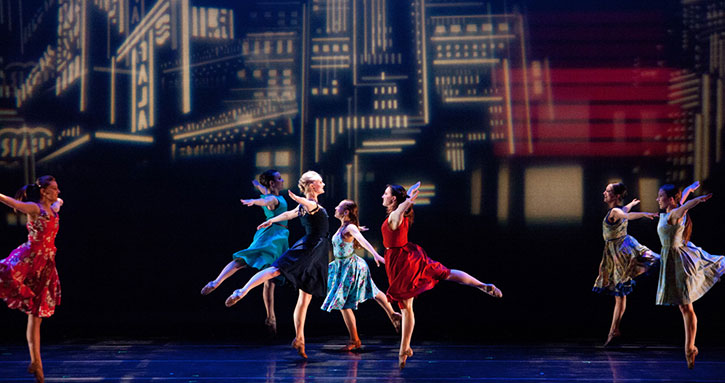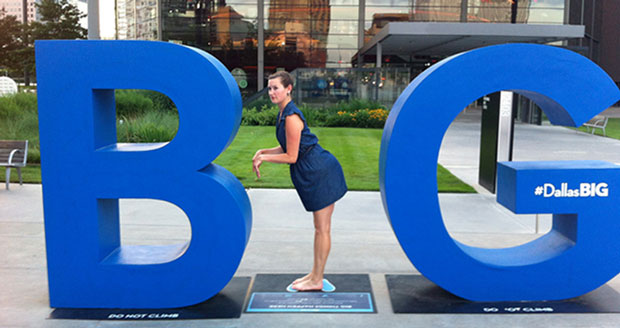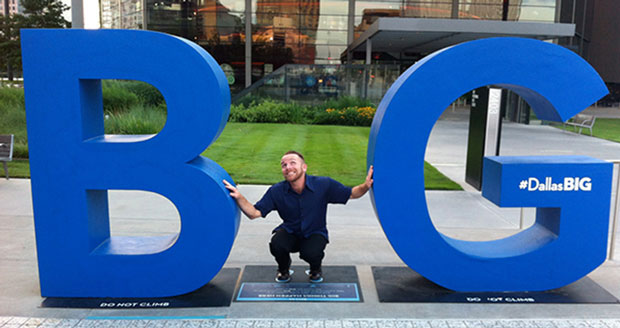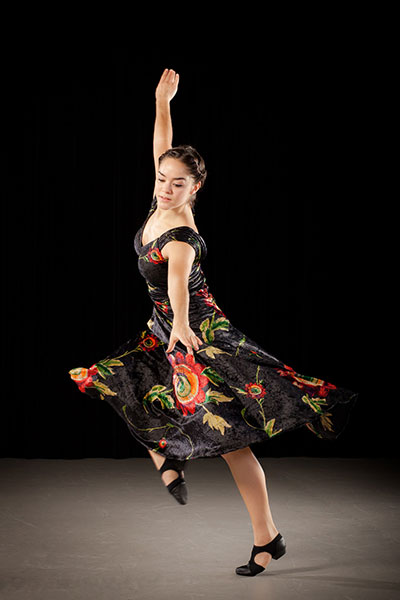A Report from the 2014 Teaching Jazz Dance Symposium
Professor Danny Buraczeski reports on results of bi-annual event and next steps

Hosted by the Meadows School of the Arts at Southern Methodist University, developed and directed by Professor Danny Buraczeski, the second Teaching Jazz Dance Symposium brought together educators, choreographers and dancers from across the country for three days, June 16-18. Technique classes, formal presentations and informal discussions helped participants create strategies to maintain and develop the relevancy and vitality of jazz dance in a contemporary artistic environment.
Here is Professor Buraczeski’s in-depth report on the symposium:
The symposium was organized around topics and ideas of key interest to the participants. They included designing a thorough warm-up; swing exercises and across-the-floor sequences in preparation for a full end-of-class combination; the analysis and practical application of the technique of a jazz dance master teacher and pioneer; the use of contemporary thought on somatics and body awareness as it applies to jazz dance training; and teaching technique from a musical perspective.
Over three days, daily technique classes were given. All symposium participants agreed that they were not there to “teach” each other anything. They were there to share perspectives and personal approaches to jazz dance pedagogy. Michele Dunleavy, Associate Professor at Penn State University, and I shared the first morning’s class. Michele gave a thorough, hour-long warm-up that was both spatially aware and rhythmically driven. I then led the class in a complex swing exercise followed by across-the-floor sequences. These sequences were based on ideas learned from Betsy Haug, an influential jazz teacher in New York in the ‘70s and ‘80s and my greatest inspiration. This led to a discussion of classes in New York at that time. It was remarked that the “scene” was gritty, classes taught in funky spaces in the heart of the theater district. The teachers singled out were Betsy Haug, Ron Forella, Phil Black, Luigi, Chuck Kelly, John Mederios, Frank Pietri and Jo Jo Smith.
Monday afternoon was dedicated to the legacy, technique and importance of jazz dance pioneer Matt Mattox. Bob Boross, Visiting Associate Professor of Jazz Dance at Shenandoah University and Matt Mattox scholar, gave a one-hour presentation that included biographical info, slides, film and personal reflections on his studies with Mattox and on research for his M.F.A. thesis IMAGE OF PERFECTION – The Freestyle Dance of Matt Mattox.
The presentation was followed by a two-hour technique class that included classic warm-up exercises and a lengthy combination choreographed by Mattox himself. Boross stressed that Matt Mattox was a ballet dancer working with balletic concepts influenced by Jack Cole isolation techniques. The term freestyle was first coined by Eugene Loring in Los Angeles in the late 1940s. It refers to a technique that is free from any one style. The technique develops the dancer’s overall abilities through exercises of isolation, coordination, polyrhythm of body parts and concentration.
To those symposium participants not familiar with the technique, the class was quite a challenge. Boross gave just enough material, allowing for a deep investigation of a few core exercises. It was exhilarating, exhausting and eye opening. The work exhibited a remarkable level of sophistication and detail that made the participants want to learn more.

The symposium’s first day ended with a passionate presentation by Erinn Liebhard of Minneapolis, an M.F.A. candidate at the University of Colorado at Boulder, and co-founder and artistic director of the Twin Cities’ Rhythmically Speaking. Her topic was “A Music-First Approach for a Historically Based Jazz Dance Class.” Erinn proposed a new way of teaching jazz dance, prioritizing deep embodiment of music, creating a practice that is a powerful carrier of cultural history. This is in contrast to a class that has a chronological, history-first approach or one with a pop culture slant that forgoes such historical knowledge. Erinn’s perspective involves teaching jazz dance technique and history by way of musical concepts. She suggested 12 units:
- Rhythm – Down Beat and Tempo, Groove
- Rhythm – Polyrhythm and Rhythmic Accuracy
- Rhythm – Syncopation and Swing
- Melody – Motif and Blue Sound
- Form – Call, Response and Comment
- Harmony – Tonal and Atonal
- Harmony – Canon and Borrowing
- Timbre – Dynamics and High Affect Juxtaposition
- Timbre – Accenting, Staccato, Legato, Sforzando
- Improvisation
- Interaction
- The Whole Sound
Each unit addresses both dance and music. One is free to find music as an auditory base for each of the units. This is a way to make the course specific and personal.
This proved to be an exciting and innovative approach reconnecting historical understanding to current practices in jazz dance.

Tuesday began with a class taught by Jeffrey Peterson, Assistant Professor of Dance at Muhlenberg College in Pennsylvania. The two-hour session applied specific Bartenieff Fundamentals and Laban concepts to support a full-bodied performance of jazz. Floor work led to standing and vice versa, revealing pathways of coordination. Via the use of the Patterns of Total Body Connectivity and specific Bartenieff Fundamentals, a deconstructionist and somatic approach to jazz was revealed. Across-the-floor exercises integrated polyrhythms, complex footwork and isolations, enlivened by an interplay between oppositional and body half limb-to-torso coordination. This class introduced symposium participants to a rich use of Laban/Bartenieff methods and language in getting to and enlivening the prime components of jazz dance.
The afternoon began with my presentation called “Three Books.” Walk into any university performing arts library and you would be hard pressed to find many scholarly books about jazz dance. Up until this year, you might easily find two: the go-to book Jazz Dance – The Story of American Vernacular Dance by Marshall and Jean Stearns, and Anthology of American Jazz Dance, authored and edited by Gus Giordano. The Stearns book was originally published in 1970, and updated with a new forward by Brenda Bufalino in 1994. The Giordano work was published in 1975.
A new anthology has recently been published and is a welcome addition: Jazz Dance – A History of the Roots and Branches, edited by Lindsay Guarino and Wendy Oliver. The book is organized into seven parts containing essays on topics that range from What is Jazz Dance? and Jazz Dance History to Contemporary Topics in Jazz Dance. As with many anthologies, the book’s strength is that a reader can pick a topic of interest and let it lead you where it leads you. Some chapters address subject matter that has already been over-analyzed. Other chapters and essays address new topics with new information and considerable insight. Some of the most perceptive chapters were written by symposium participant Bob Boross.
Following a brief discussion, I showed a DVD titled Peter Gennaro – the Dancing Man. The video chronicles the remarkable career of an often forgotten man of jazz, choreographer of all the Latin dances in West Side Story, The Unsinkable Molly Brown, Fiorello and Annie, among other Broadway shows. He was a major presence on American television, choreographing and dancing for the Perry Como Show, Ed Sullivan Show and Judy Garland Show. It was remarked that both Peter Gennaro and Gus Giordano studied with the legendary Katherine Dunham on the G.I. Bill.
The afternoon concluded with a two-hour class, “Mobilizing the Spine in Concert Jazz Technique,” taught by Michelle Ikle’, Associate Professor and Chair of Dance at Hobart and William Smith Colleges. Somatic techniques were used to enliven the body’s core, focusing on the mobility of the spine. This mobility was accessed through self-sensing and Touch Technique. Participants were paired up. One closed his or her eyes, and then their partner touched a place on their body that generated a movement source. It was interesting and it authentically looked like jazz. The class continued with across-the-floor material and, as dancers, the participants felt newly grounded and refreshed after a long day.
The day concluded with a short conversation via Skype with Cathy Young, Director of Dance at the Boston Conservatory.

Caption: A scene from Buraczeski’s Deep Ellum Nights
The final morning of the symposium began with a warm-up by Michele Dunleavy, a repeat of my swing exercise and a review of the Matt Mattox tendu with Bob Boross. Judith James Ries, a faculty member teaching jazz dance at the St. Paul Conservatory for the Performing Arts, then taught a dynamic movement sequence. It was designed to learn movement intuitively without counting. It was complex and used accumulation to great effect. As with everything in the symposium, rhythm was at its core.
Jeffrey Peterson then taught a musically challenging and demanding combination revisiting concepts from his class the day before. Following this team-taught class, it was remarked that the two-and-a-half-day symposium felt like it included at least a week’s worth of material.
The symposium concluded with a working lunch and discussion, synthesizing all the ideas expressed and explored in both movement and language. All agreed that the symposium was valuable and should continue again in 2016. All participants felt honored and energized. The main question was how to create forums for conversation and discussion across the field that would reposition jazz dance as a substantive choreographic language. It was agreed that we should:
- Create a Teaching Jazz Dance Symposium FaceBook page, a place to continue dialogue and develop more interest in the bi-annual event.
- Stop trying to “legitimize” jazz dance in our own institutions. Rather, we must fight ignorance and educate our students, peers and audiences about what we do, reflecting our strongly held belief that the modern/ballet model for dance training is incomplete.
- Continue to articulate the prime tenets of jazz dance but in new ways.
- Encourage the integration of jazz dance into other parts of the curriculum, including within Dance History and Dance Composition classes and choreographic experiences, while also interfacing with African-American Studies and World Music programs, and providing more collaboration with music departments.
- Find a way to access, promote and teach jazz choreography via a repertory or “variations” class.
Choreographers whose work was suggested were:
- Katherine Dunham
- Donald McKayle
- Talley Beatty
- Jerome Robbins
- Matt Mattox
- Daniel Nagrin
- Jack Cole
- Bob Fosse
- Diane McIntyre
- Gus Giordano
- Billy Siegenfeld
- Danny Buraczeski
This list represents a rich, creative and important legacy, one that needs to be celebrated.